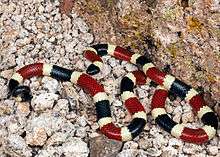Micruroides
| Micruroides euryxanthus | |
|---|---|
 | |
| Scientific classification | |
| Kingdom: | Animalia |
| Phylum: | Chordata |
| Class: | Reptilia |
| Order: | Squamata |
| Suborder: | Serpentes |
| Family: | Elapidae |
| Genus: | Micruroides K.P. Schmidt, 1928 |
| Species: | M. euryxanthus |
| Binomial name | |
| Micruroides euryxanthus (Kennicott, 1860) | |
| Synonyms | |

Micruroides euryxanthus, commonly known as the Sonoran coral snake or the Arizona coral snake, is a species of venomous elapid, which is endemic to northwestern Mexico and the southwestern United States.
Description
Adults are 11–24 inches (280–610 mm) in total length (including tail).[4]
The color pattern consists of broad, alternating rings of red and black, separated by narrower rings of white or yellow. Markings become paler as they reach the belly. The head is black,[4] the black extending to the posterior border of the parietals.[5]
The smooth dorsal scales are arranged in 15 rows at midbody. Ventrals 214-241; anal plate divided; subcaudals 21-34, also divided (paired).[6]
Micruroides euryxanthus resembles Micrurus fulvius. However, the white or yellow rings are broader than in Micrurus fulvius, and there are fewer black rings on the tail, usually only 2.[6] Also, the first ring on the body (the first ring behind the white or yellow ring on the back of the head) is red, whereas in Micrurus fulvius it is black.[7]
Venom
The venom is neurotoxic and extremely potent, but no fatalities have been reported.[4]
Habitat
M. euryxanthus is found in arid/semiarid regions in numerous habitats, both on plains and on lower mountain slopes, from sea level to 5,800 ft (1,800 m). In Arizona it is abundant in rocky upland desert.
Behavior
The Sonoran coral snake usually stays underground and comes out at night, but can also appear during and after rains.
Defense
When startled, frightened, or threatened, M. euryxanthus will hide its head under its body and raise and tightly curl its tail. While in this posture, it will fart: snakes do not have an anal cavity in the sense that humans and most mammals do, but rather a tract that allows for both disposal of waste and for laying of eggs in females. Instead it will forcibly and noisily emit gas from its cloaca, a behavior known as "cloacal popping," and predictably this phenomenon has a horrible smell.[6][8]
Diet
The Arizona coral snake preys upon small snakes, predominantly Leptotyphlops, but also Chionactis, Hypsiglena, Sonora, and Tantilla.[9] It will also eat small lizards such as skinks.[10]
Reproduction
Like all other species of New World coral snakes (genera Leptomicrurus and Micrurus), Micruroides euryxanthus is oviparous.[6] Adult females may lay up to 3 eggs, and the hatchlings are 18–20 cm (7-8 inches) in total length.[9]
Geographic range
Micruroides euryxanthus is found from central Arizona and southwestern New Mexico to Mazatlán in southern Sinaloa. Isolated populations are also found in the Chocolate Mountains, La Paz County, western Arizona and on Tiburón Island in the Gulf of California.[10]
Subspecies
Three subspecies are recognized, including the nominotypical subspecies.
- Micruroides euryxanthus australis Zweifel & Norris, 1955
- Micruroides euryxanthus euryxanthus (Kennicott, 1860)
- Micruroides euryxanthus neglectus Roze, 1967[11]
References
- ↑ Frost, D.R., Hammerson, G.A. & Gadsden, H. 2007. Micruroides euryxanthus. In: IUCN 2012. IUCN Red List of Threatened Species. Version 2012.2. <www.iucnredlist.org>. Downloaded on 10 January 2013.
- ↑ Stejneger, L., and T. Barbour. 1917. A Check List of North American Amphibians and Reptiles. Harvard University Press. Cambridge, Massachusetts. 125 pp. (Micrurus euryxanthus, p. 106.)
- ↑ Schmidt, K.P. 1928. Notes on American Coral Snakes. Bull. Antivenin Inst. America 2 (3): 63-64.
- 1 2 3 Reptiles and Amphibians of Arizona. www.reptilesofaz.org/Snakes-Subpages/h-m-euryxanthus.html.
- ↑ Boulenger, G.A. 1896. Catalogue of the Snakes in the British Museum (Natural History). Volume III., Containing the Colubridæ (Opisthoglyphæ and Proteroglyphæ)... Trustees of the British Museum (Natural History). (Taylor and Francis, Printers.) London. xiv + 727 pp. + Plates I.- XXV. (Elaps euryxanthus, p. 415.)
- 1 2 3 4 Smith, H.M., and E.D. Brodie, Jr. 1982. Reptiles of North America: A Guide to Field Identification. Golden Press. New York. 240 pp. ISBN 0-307-13666-3 (paperback). ("Elapids—family Elapidae" and "Micruroides euryxanthus", pp. 196-197.)
- ↑ Schmidt, K.P., and D.D. Davis. 1941. Field Book of Snakes of the United States and Canada. G.P. Putnam's Sons. New York. 365 pp. (Micruroides euryxanthus, pp. 276-277, Figure 91.)
- ↑ Ernst, C.H., and E.M. Ernst. 2011. Venomous Reptiles of the United States, Canada, and Northern Mexico. Volume 1: Heloderma, Micruroides, Micrurus, Pelamis, Agkistrodon, Sistrurus. Johns Hopkins University Press. Baltimore. xviii + 392 pp. ISBN 0-8018-9875-7. (Micruroides euryxanthus...behavior, p. 111.)
- 1 2 Hubbs, B., and B. O'Connor. 2012. A Guide to the Rattlesnakes and other Venomous Serpents of the United States. Tricolor Books. Tempe, Arizona. 129 pp. ISBN 978-0-9754641-3-7 (paperback). (Micruroides euryxanthus euryxanthus, pp. 86-87, 122.)
- 1 2 Stebbins, R.C. 2003. A Field Guide to Western Reptiles and Amphibians, Third Edition. The Peterson Field Guide Series. Houghton Mifflin. Boston and New York.
533 pp. ISBN 0-395-98272-3 (paperback). (Micruroides euryxanthus, pp. 405-496 + Plate 44 + Map 181.) - ↑ ITIS (Integrated Taxonomic Information System). www.itis.gov.
Further reading
- Kennicott, R. 1860. Descriptions of New Species of North American Serpents in the Museum of the Smithsonian Institution, Washington. Proc. Acad. Nat. Sci. Philadelphia 12: 328-338. (Elaps euryxanthus, pp. 337–338.)
- Roze, J.A. 1974. Micruroides, M. euryxanthus. Catalogue of American Amphibians and Reptiles (163): 1-4. (Micruroides euryxanthus neglectus)
- Wright, A.H., and A.A. Wright. 1957. Handbook of Snakes of the United States and Canada. Comstock. Ithaca and London. 1,105 pp. (in 2 volumes) (Family Elapidae, p. 885; Genus Micruroides, pp. 885–886; and Micruroides euryxanthus, pp. 886–890, Figures 253.-255. + Map 63. on p. 891.)
- Zweifel, R.G., and K.S. Norris. 1955. Contributions to the herpetology of Sonora, Mexico: Descriptions of new subspecies of snakes (Micruroides euryxanthus and Lampropeltis getulus) and miscellaneous collecting notes. Amer. Midland Naturalist 54: 230-249. (Micruroides euryxanthus australis, p. 238.)
